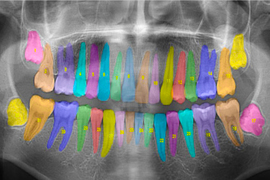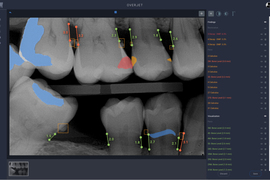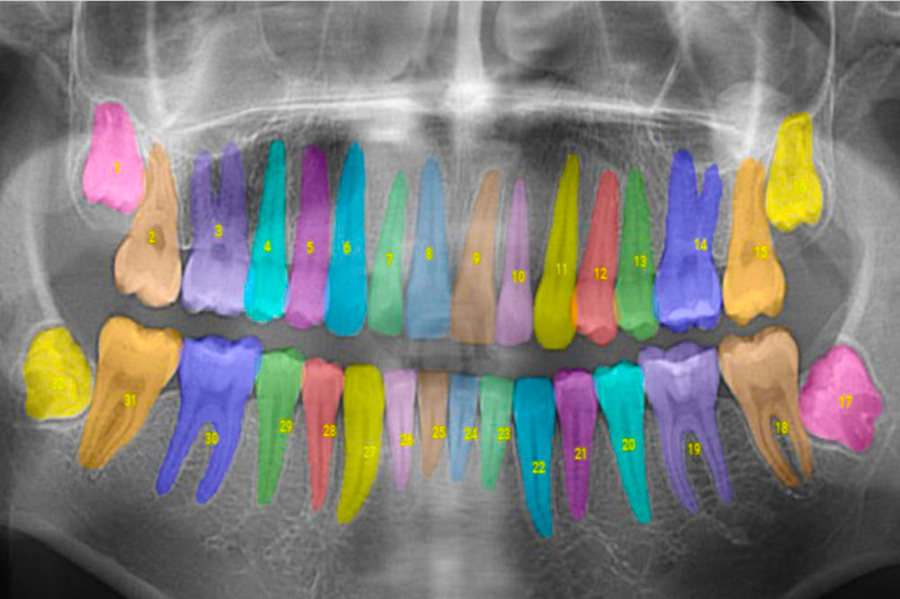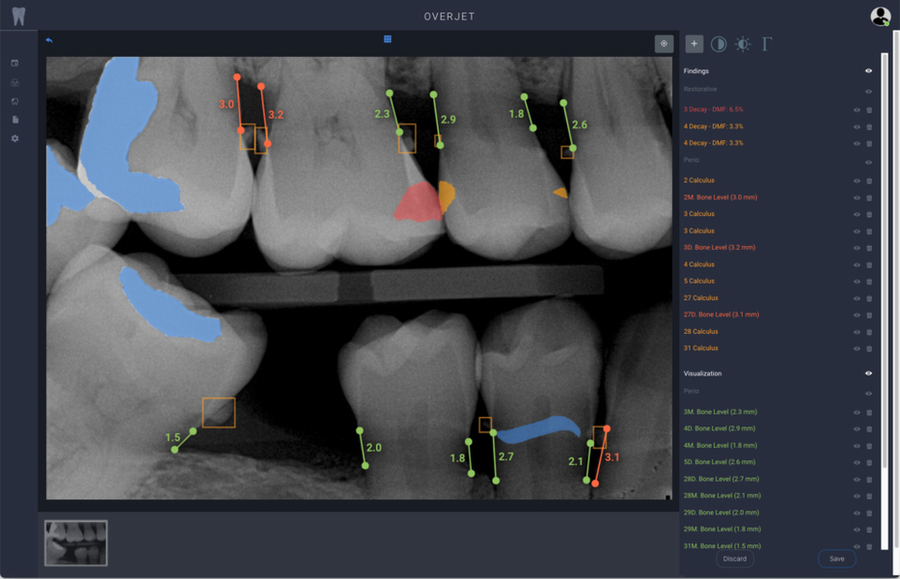When you picture a hospital radiologist, you might think of a specialist who sits in a dark room and spends hours poring over X-rays to make diagnoses. Contrast that with your dentist, who in addition to interpreting X-rays must also perform surgery, manage staff, communicate with patients, and run their business. When dentists analyze X-rays, they do so in bright rooms and on computers that aren’t specialized for radiology, often with the patient sitting right next to them.
Is it any wonder, then, that dentists given the same X-ray might propose different treatments?
“Dentists are doing a great job given all the things they have to deal with,” says Wardah Inam SM ’13, PhD ’16.
Inam is the co-founder of Overjet, a company using artificial intelligence to analyze and annotate X-rays for dentists and insurance providers. Overjet seeks to take the subjectivity out of X-ray interpretations to improve patient care.
“It’s about moving toward more precision medicine, where we have the right treatments at the right time,” says Inam, who co-founded the company with Alexander Jelicich ’13. “That’s where technology can help. Once we quantify the disease, we can make it very easy to recommend the right treatment.”
Overjet has been cleared by the Food and Drug Administration to detect and outline cavities and to quantify bone levels to aid in the diagnosis of periodontal disease, a common but preventable gum infection that causes the jawbone and other tissues supporting the teeth to deteriorate.
In addition to helping dentists detect and treat diseases, Overjet’s software is also designed to help dentists show patients the problems they’re seeing and explain why they’re recommending certain treatments.
The company has already analyzed tens of millions of X-rays, is used by dental practices nationwide, and is currently working with insurance companies that represent more than 75 million patients in the U.S. Inam is hoping the data Overjet is analyzing can be used to further streamline operations while improving care for patients.
“Our mission at Overjet is to improve oral health by creating a future that is clinically precise, efficient, and patient-centric,” says Inam.
It’s been a whirlwind journey for Inam, who knew nothing about the dental industry until a bad experience piqued her interest in 2018.
Getting to the root of the problem
Inam came to MIT in 2010, first for her master’s and then her PhD in electrical engineering and computer science, and says she caught the bug for entrepreneurship early on.
“For me, MIT was a sandbox where you could learn different things and find out what you like and what you don't like,” Inam says. “Plus, if you are curious about a problem, you can really dive into it.”
While taking entrepreneurship classes at the Sloan School of Management, Inam eventually started a number of new ventures with classmates.
“I didn't know I wanted to start a company when I came to MIT,” Inam says. “I knew I wanted to solve important problems. I went through this journey of deciding between academia and industry, but I like to see things happen faster and I like to make an impact in my lifetime, and that's what drew me to entrepreneurship.”
During her postdoc in the Computer Science and Artificial Intelligence Laboratory (CSAIL), Inam and a group of researchers applied machine learning to wireless signals to create biomedical sensors that could track a person’s movements, detect falls, and monitor respiratory rate.
She didn’t get interested in dentistry until after leaving MIT, when she changed dentists and received an entirely new treatment plan. Confused by the change, she asked for her X-rays and asked other dentists to have a look, only to receive still another variation in diagnosis and treatment recommendations.
At that point, Inam decided to dive into dentistry for herself, reading books on the subject, watching YouTube videos, and eventually interviewing dentists. Before she knew it, she was spending more time learning about dentistry than she was at her job.
The same week Inam quit her job, she learned about MIT’s Hacking Medicine competition and decided to participate. That’s where she started building her team and getting connections. Overjet’s first funding came from the Media Lab-affiliated investment group the E14 Fund.
“The E14 fund wrote the first check, and I don't think we would've existed if it wasn't for them taking a chance on us,” she says.
Inam learned that a big reason for variation in treatment recommendations among dentists is the sheer number of potential treatment options for each disease. A cavity, for instance, can be treated with a filling, a crown, a root canal, a bridge, and more.
When it comes to periodontal disease, dentists must make millimeter-level assessments to determine disease severity and progression. The extent and progression of the disease determines the best treatment.
“I felt technology could play a big role in not only enhancing the diagnosis but also to communicate with the patients more effectively so they understand and don't have to go through the confusing process I did of wondering who's right,” Inam says.
Overjet began as a tool to help insurance companies streamline dental claims before the company began integrating its tool directly into dentists’ offices. Every day, some of the largest dental organizations nationwide are using Overjet, including Guardian Insurance, Delta Dental, Dental Care Alliance, and Jefferson Dental and Orthodontics.
Today, as a dental X-ray is imported into a computer, Overjet’s software analyzes and annotates the images automatically. By the time the image appears on the computer screen, it has information on the type of X-ray taken, how a tooth may be impacted, the exact level of bone loss with color overlays, the location and severity of cavities, and more.
The analysis gives dentists more information to talk to patients about treatment options.
“Now the dentist or hygienist just has to synthesize that information, and they use the software to communicate with you,” Inam says. “So, they'll show you the X-rays with Overjet's annotations and say, 'You have 4 millimeters of bone loss, it's in red, that's higher than the 3 millimeters you had last time you came, so I'm recommending this treatment.”
Overjet also incorporates historical information about each patient, tracking bone loss on every tooth and helping dentists detect cases where disease is progressing more quickly.
“We’ve seen cases where a cancer patient with dry mouth goes from nothing to something extremely bad in six months between visits, so those patients should probably come to the dentist more often,” Inam says. “It’s all about using data to change how we practice care, think about plans, and offer services to different types of patients.”
The operating system of dentistry
Overjet’s FDA clearances account for two highly prevalent diseases. They also put the company in a position to conduct industry-level analysis and help dental practices compare themselves to peers.
“We use the same tech to help practices understand clinical performance and improve operations,” Inam says. “We can look at every patient at every practice and identify how practices can use the software to improve the care they're providing.”
Moving forward, Inam sees Overjet playing an integral role in virtually every aspect of dental operations.
“These radiographs have been digitized for a while, but they've never been utilized because the computers couldn't read them,” Inam says. “Overjet is turning unstructured data into data that we can analyze. Right now, we're building the basic infrastructure. Eventually we want to grow the platform to improve any service the practice can provide, basically becoming the operating system of the practice to help providers do their job more effectively.”











